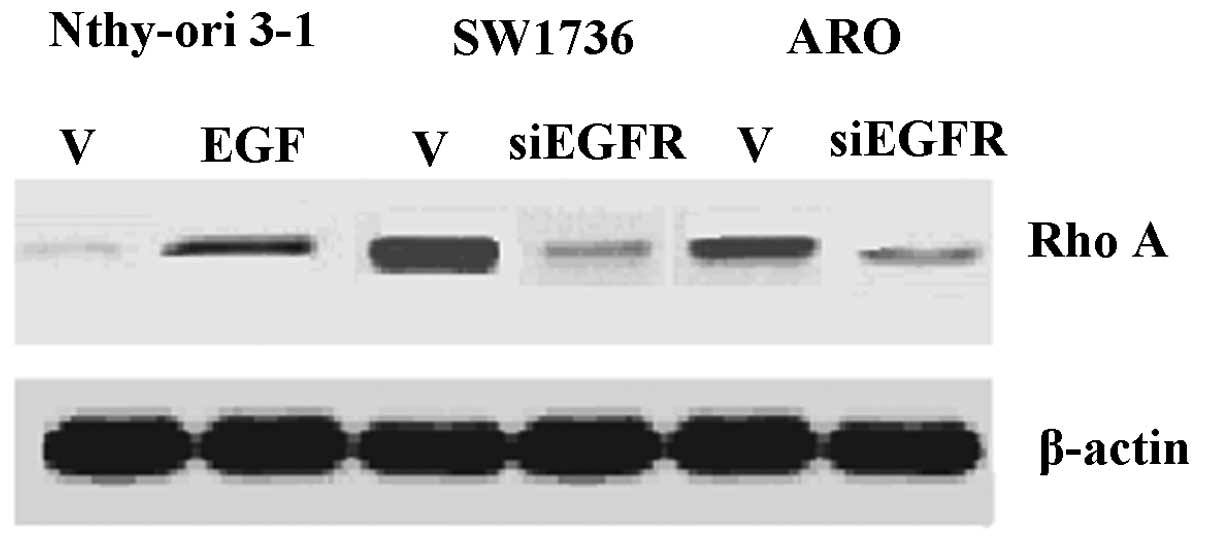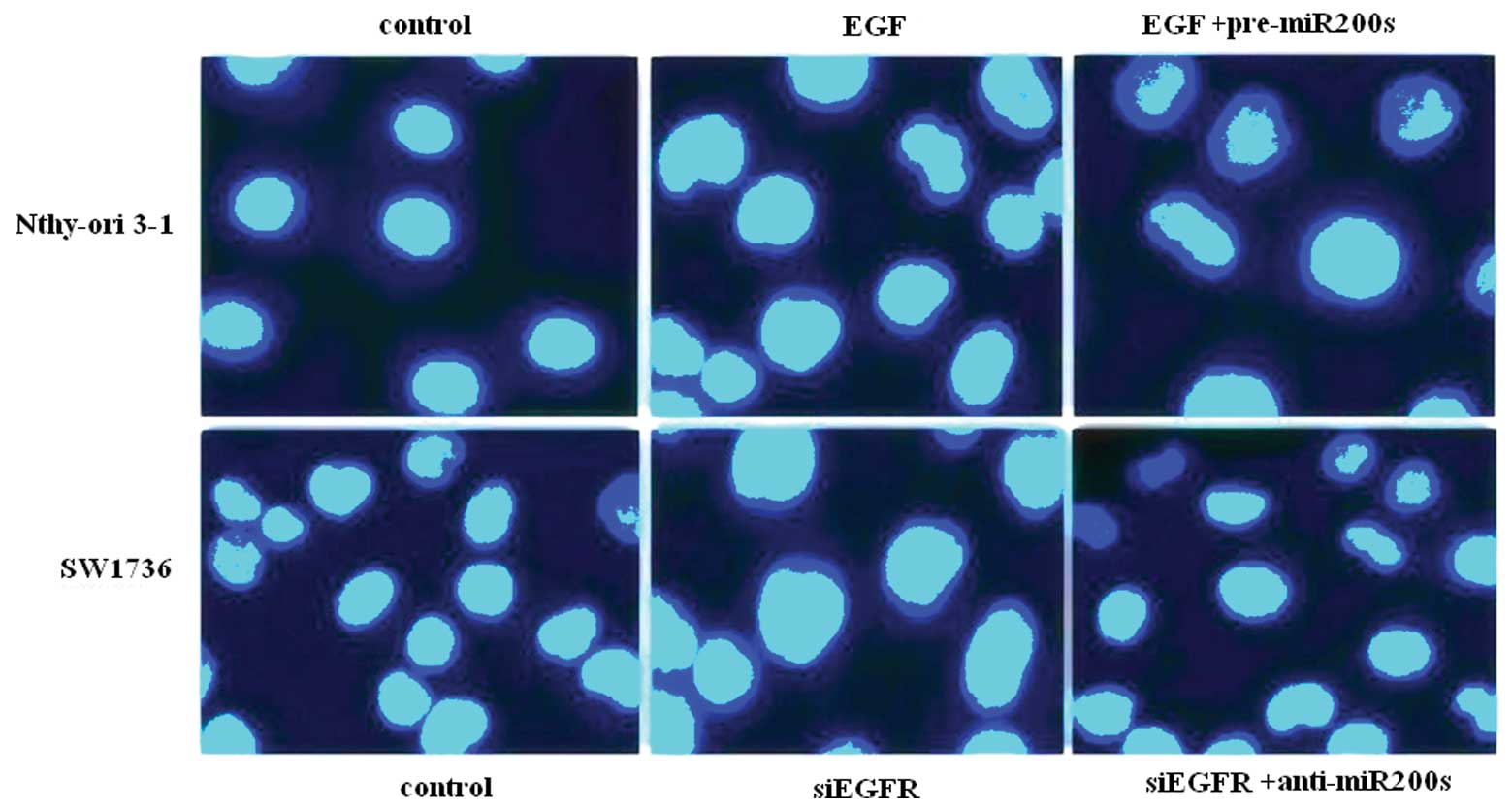|
1.
|
G Riesco-EizaguirreP SantistebanNew
insights in thyroid follicular cell biology and its impact in
thyroid cancer therapyEndocr Relat
Cancer14957977200710.1677/ERC-07-008518045949
|
|
2.
|
KN PatelAR ShahaPoorly differentiated and
anaplastic thyroid cancerCancer Control13119128200616735986
|
|
3.
|
WB ZhongYC LiangCY WangTC ChangWS
LeeLovastatin suppresses invasiveness of anaplastic thyroid cancer
cells by inhibiting Rho geranylgeranylation and RhoA/ROCK
signalingEndocr Relat
Cancer12615629200510.1677/erc.1.0101216172195
|
|
4.
|
L LarueA BellacosaEpithelial-mesenchymal
transition in development and cancer: role of phosphatidylinositol
30 kinase/AKT
pathwaysOncogene2474437454200510.1038/sj.onc.120909116288291
|
|
5.
|
JP ThieryH AcloqueRY HuangMA
NietoEpithelialmesenchymal transitions in development and
diseaseCell139871890200910.1016/j.cell.2009.11.00719945376
|
|
6.
|
JJ ChristiansenAK RajasekaranReassessing
epithelial to mesenchymal transition as a prerequisite for
carcinoma invasion and metastasisCancer
Res6683198326200610.1158/0008-5472.CAN-06-041016951136
|
|
7.
|
JD BergstromB WestermarkNE HeldinEpidermal
growth factor receptor signaling activates met in human anaplastic
thyroid carcinoma cellsExp Cell
Res259293299200010.1006/excr.2000.4967
|
|
8.
|
CT KuanCJ WikstrandDD BignerEGF mutant
receptor vIII as a molecular target in cancer therapyEndocr Relat
Cancer88396200110.1677/erc.0.008008311397666
|
|
9.
|
AK LarsenD OuaretK El OuadraniA
PetitprezTargeting EGFR and VEGF(R) pathway cross-talk in tumor
survival and angiogenesisPharmacol
Ther1318090201110.1016/j.pharmthera.2011.03.01221439312
|
|
10.
|
T CasconeMH HerynkL XuZ DuH KadaraMB
NilssonCJ ObornYY ParkB ErezJJ JacobyUpregulated stromal EGFR and
vascular remodeling in mouse xenograft models of angiogenesis
inhibitor-resistant human lung adenocarcinomaJ Clin
Invest12113131328201110.1172/JCI4240521436589
|
|
11.
|
L Ferrer-SolerA Vazquez-MartinJ BrunetJA
MenendezRD LlorensR ColomerAn update of the mechanisms of
resistance to EGFR-tyrosine kinase inhibitors in breast cancer:
Gefitinib (Iressa)-induced changes in the expression and
nucleocytoplasmic trafficking of HER-ligands (Review)Int J Mol
Med203102007
|
|
12.
|
V Sanz-MorenoC GaggioliM YeoJ AlbrenguesF
WallbergA VirosS HooperR MitterCC FéralM CookROCK and JAK1
signaling cooperate to control actomyosin contractility in tumor
cells and stromaCancer
Cell20229245201110.1016/j.ccr.2011.06.01821840487
|
|
13.
|
Z ZhangJH RenZY LiL NongG WuFasudil
inhibits lung carcinoma-conditioned endothelial cell viability and
migrationOncol Rep2715611566201222344855
|
|
14.
|
G MavriaY VercoulenM YeoH PatersonM
KarasaridesR MaraisD BirdCJ MarshallERK-MAPK signaling opposes
Rho-kinase to promote endothelial cell survival and sprouting
during angiogenesisCancer
Cell93344200610.1016/j.ccr.2005.12.02116413470
|
|
15.
|
WB ZhongSP HsuPY HoYC LiangTC ChangWS
LeeLovastatin inhibits proliferation of anaplastic thyroid cancer
cells through up-regulation of p27 by interfering with the
Rho/ROCK-mediated pathwayBiochem
Pharmacol8216631672201110.1016/j.bcp.2011.08.02121907187
|
|
16.
|
Y KideraM TsubakiY YamazoeK ShojiH
NakamuraM OgakiT SatouT ItohM IsozakiJ KanekoReduction of lung
metastasis, cell invasion, and adhesion in mouse melanoma by
statin-induced blockade of the Rho/Rho- associated coiled-coil
containing protein kinase pathwayJ Exp Clin Cancer
Res29127201010.1186/1756-9966-29-12720843370
|
|
17.
|
JA FoekensAM SieuwertsM SmidMP LookV de
WeerdAW BoersmaJG KlijnEA WiemerJW MartensFour miRNAs associated
with aggressiveness of lymph node-negative estrogen
receptor-positive human breast cancerProc Natl Acad Sci
USA1051302113026200810.1073/pnas.080330410518755890
|
|
18.
|
L MaJ Teruya-FeldsteinRA WeinbergTumour
invasion and metastasis initiated by microRNA-10b in breast
cancerNature449682688200710.1038/nature0617417898713
|
|
19.
|
PA GregoryAG BertEL PatersonSC BarryA
TsykinG FarshidMA VadasY Khew-GoodallGJ GoodallThe miR-200 family
and miR-205 regulate epithelial to mesenchymal transition by
targeting ZEB1 and SIP1Nat Cell
Biol10593601200810.1038/ncb172218376396
|
|
20.
|
SM ParkAB GaurE LengyelME PeterThe miR-200
family determines the epithelial phenotype of cancer cells by
targeting the E-cadherin repressors ZEB1 and ZEB2Genes
Dev22894907200810.1101/gad.164060818381893
|
|
21.
|
D KongY LiZ WangS BanerjeeA AhmadHR KimFH
SarkarmiR-200 regulates PDGF-D-mediated epithelialmesenchymal
transition, adhesion, and invasion of prostate cancer cellsStem
Cells2717121721200910.1002/stem.10119544444
|
|
22.
|
L YinK MorishigeT TakahashiK HashimotoS
OgataS TsutsumiK TakataT OhtaJ KawagoeK TakahashiH KurachiFasudil
inhibits vascular endothelial growth factor-induced angiogenesis in
vitro and in vivoMol Cancer
Ther615171525200710.1158/1535-7163.MCT-06-068917513600
|
|
23.
|
JM HarveyGM ClarkCK OsborneDC
AllredEstrogen receptor status by immunohistochemistry is superior
to the ligand-binding assay for predicting response to adjuvant
endocrine therapy in breast cancerJ Clin
Oncol1714741481199910334533
|
|
24.
|
S UmemuraJ ItohH ItohA SerizawaY SaitoY
SuzukiY TokudaT TajimaRY OsamuraImmunohistochemical evaluation of
hormone receptors in breast cancer: which scoring system is
suitable for highly sensitive procedures?Appl Immunohistochem Mol
Morphol12813200410.1097/00129039-200403000-00002
|
|
25.
|
A WunderlichM FischerT SchlosshauerA
RamaswamyBH GreeneC BrendelD DollD BartschS HoffmannEvaluation of
Aurora kinase inhibition as a new therapeutic strategy in
anaplastic and poorly differentiated follicular thyroid
cancerCancer Sci102762768201110.1111/j.1349-7006.2011.01853.x
|
|
26.
|
H YingSL BirocWW LiB AlickeJA XuanR
PagilaY OhashiT OkadaY KamataH DinterThe Rho kinase inhibitor
fasudil inhibits tumor progression in human and rat tumor modelsMol
Cancer Ther521582164200610.1158/1535-7163.MCT-05-044016985048
|
|
27.
|
HJ ChoJ YooRho activation is required for
transforming growth factor-beta-induced epithelial-mesenchymal
transition in lens epithelial cellsCell Biol
Int3112251230200710.1016/j.cellbi.2007.04.00617537651
|
|
28.
|
GP SunM KohnoP GuoY NagaiK MiyataYY FanS
KimuraH KiyomotoK OhmoriDT LiY AbeA NishiyamaInvolvements of
Rho-kinase and TGF-beta pathways in aldosterone-induced renal
injuryJ Am Soc
Nephrol1721932201200610.1681/ASN.200512137516790507
|


















